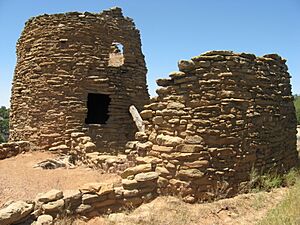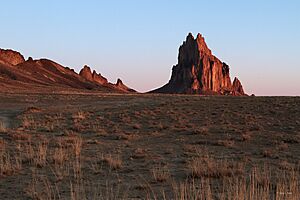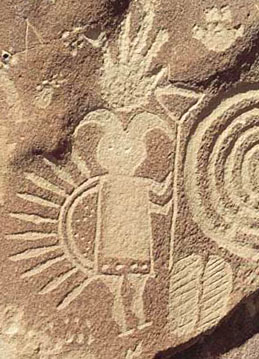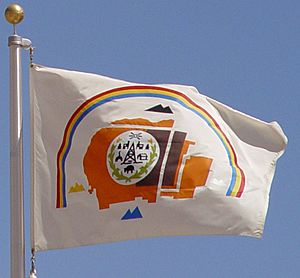Dinétah facts for kids
Dinétah is the special homeland of the Navajo tribe, who are Native Americans. In the Navajo language, the word "Dinétah" means "among the people" or "among the Navajo." The Navajo word diné refers to the Navajo people themselves, and it also means "people" in general. The part -tah means "among" or "in the area of."
Geographically, Dinétah covers a large area. It includes parts of northwestern New Mexico, southwestern Colorado, southeastern Utah, and northeastern Arizona. The exact borders are not always clear, but they are often marked by important mountain peaks that point to the four main directions (north, south, east, west).
Contents
What is the Land Like in Dinétah?
The Dinétah region has tall, flat-topped hills called mesas and deep, narrow valleys called canyons. These canyons lead to the San Juan River. The canyons are made of layers of sandstone, with many ledges and slopes.
The land is usually about 5,000 to 6,500 feet high. Some mountain peaks in the area rise even higher, to more than 14,000 feet. The traditional boundaries of Dinétah are marked by four sacred mountains:
- Blanca Peak (Sis Naajinį́) to the east.
- Mount Taylor (Tsoodzil) to the south.
- The San Francisco Peaks (Dook'o'ooshį́į́) to the west.
- Hesperus Peak (Dibé Nitsaa) to the north.
The Navajo people see Dinétah as their ancient homeland. Their traditional creation story is centered around this area. Many Navajo place names in the region tell stories about their myths and beliefs.
While Dinétah is a large area, the most important part is considered to be the canyons of the Largo and Carrizo washes. These are south of the San Juan River in New Mexico. They are located east and south of Farmington, New Mexico. This area includes Blanco, Largo, Carrizo, and Gobernador Canyons.
The importance of Dinétah is found in Navajo oral history. It is also supported by many archaeological sites and rock art carvings. According to Navajo tradition, a very important Navajo deity named Changing Woman (Asdzą́ą́ Nádleehé) was found by the Holy People (Diyin Dineʼé) on top of Gobernador Knob (Chʼóolʼį́ʼí), which is in Dinétah. This region is also where the first four Navajo clans arrived after traveling from the western ocean.

Thousands of ancient sites have been found in the Dinétah region. These sites include remains from different cultures, such as the Ancestral Puebloans (also called the Anasazi), the Navajo, and early Hispanic settlers. The dry climate of the region has helped to preserve many types of sites. These include stone and wood structures, as well as pictographs (paintings on rock) and petroglyphs (carvings on rock).
The most noticeable ancient sites are called Navajo pueblitos. These are usually stone buildings with one to six rooms. Experts believe these pueblitos were built around the end of the 1600s. They seem to have been built mainly for defense. Pueblitos can be multi-story towers, fort-like enclosures, or homes built into cliffs. Several pueblitos are listed on the List of Registered Historic Places in New Mexico.
There is growing evidence that the Navajo people were in Dinétah as early as the 1500s. While there is still some discussion about the exact dates, it is generally agreed that they lived in Dinétah well before the Pueblo Revolt of 1680.
Archaeologists divide the Navajo time in Dinétah into two main periods:
- The Dinétah phase (around 1500-1630): This was when the Navajo first arrived and settled in the area.
- The Gobernador phase (around 1630-1800): During this time, the Navajo culture became fully developed. This phase is known for finding special pottery called Gobernador Polychrome and the building of pueblitos.
Around 1750, the Navajo population started moving south and west. This was because of pressure from the Spanish and Utes. By about 1800, they had left the main part of the Dinétah region.




